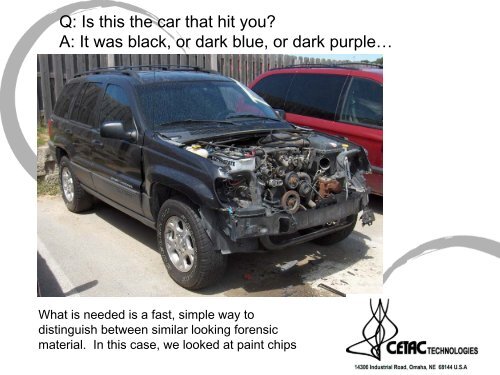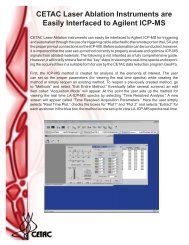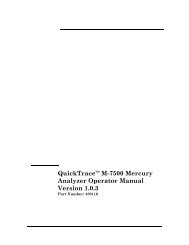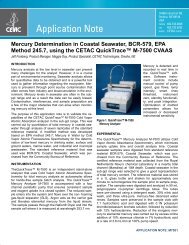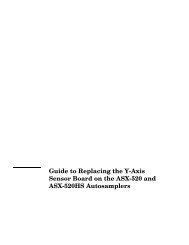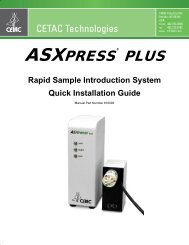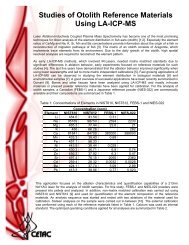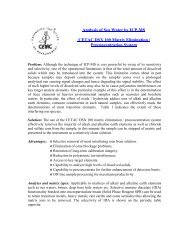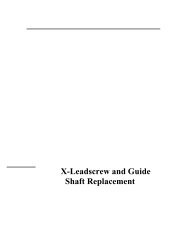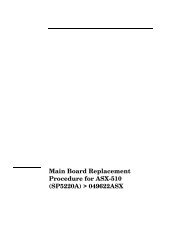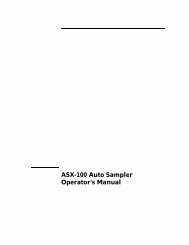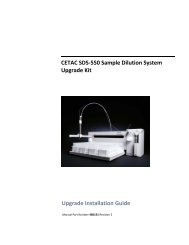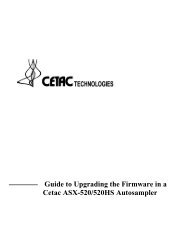Auto Paint Analysis using the LSX-213 Laser Ablation system
Auto Paint Analysis using the LSX-213 Laser Ablation system
Auto Paint Analysis using the LSX-213 Laser Ablation system
You also want an ePaper? Increase the reach of your titles
YUMPU automatically turns print PDFs into web optimized ePapers that Google loves.
Q: Is this <strong>the</strong> car that hit you?<br />
A: It was black, or dark blue, or dark purple…<br />
What is needed is a fast, simple way to<br />
distinguish between similar looking forensic<br />
material. In this case, we looked at paint chips
The CETAC <strong>LSX</strong>-<strong>213</strong> <strong>Laser</strong> <strong>Ablation</strong> <strong>system</strong> is <strong>the</strong> perfect<br />
solution for <strong>the</strong> analysis of virtually any solid material<br />
• Integrates seamlessly with <strong>the</strong> Varian, Thermo,<br />
PerkinElmer Elan ICP-MS or any o<strong>the</strong>r ICP-MS or<br />
OES<br />
• <strong>Laser</strong> ablation is a versatile solid sampling<br />
technique, used for qualitative and quantitative<br />
analysis with ICP-OES and ICP-MS <strong>system</strong>s<br />
• Useful for microscopic feature analysis for<br />
geological, forensic and failure analysis<br />
applications or macroscopic material identification<br />
• Also useful for difficult to digest materials with<br />
reduced contamination risk compared to liquid<br />
digestion methods<br />
• Capable of quantitative minor and trace analyses of<br />
virtually and solid or semi-solid material<br />
• The DigiLaz<strong>213</strong> software allows a wide variety of<br />
ablation patterns and parameters<br />
• Excellent illumination and digital video <strong>system</strong><br />
allow precise imaging of samples with high<br />
intensity, polarized reflected and transmitted light<br />
sources
CETAC <strong>LSX</strong>-<strong>213</strong> simplified schematic
Problem: Characterizing forensic material<br />
• Typically, paint chips are left at <strong>the</strong> scene of any auto accident<br />
• In this example, we characterized a group of paints which appear very<br />
similar<br />
• The goal is to get a rare earth “fingerprint” of each paint to differentiate<br />
samples as a fast and simple method requiring only gas blank subtracted<br />
intensities for analysis
<strong>Auto</strong> <strong>Paint</strong> <strong>Analysis</strong>: Considerations<br />
• Energy Attenuation is of great importance since <strong>the</strong> goal is to<br />
ablate only <strong>the</strong> paint while leaving <strong>the</strong> underlying surface intact<br />
• The <strong>LSX</strong>-<strong>213</strong> uses optical attenuation to give precise, linear<br />
energy levels<br />
• <strong>Auto</strong> <strong>Paint</strong> primer is very high in Chromium making Cr 52 a good<br />
“break-through” indicator<br />
• The “Metallic” look of auto paint is achieved <strong>using</strong> Aluminum<br />
flake, making <strong>the</strong> presence of Aluminum a quick indicator of this<br />
paint style<br />
• Titanium Dioxide is nearly universal in auto paint and is <strong>the</strong><br />
primary pigment. Titanium can be used to “normalize” o<strong>the</strong>r<br />
element values for semi-quantitative analysis of <strong>the</strong> pigment.<br />
• For “finger printing”, rare earth elements are preferable due to<br />
<strong>the</strong>ir low environmental background and variability with various<br />
pigment raw materials<br />
• Cerium, Hafnium and Rhodium were chosen due to <strong>the</strong>ir high<br />
degree of variability among samples and stable signal,<br />
indicating a homogenous distribution throughout <strong>the</strong> sample
Selected rare earth values from 8<br />
paints, all “very dark blue or black”<br />
10000000.0<br />
1000000.0<br />
100000.0<br />
10000.0<br />
1000.0<br />
Ce140<br />
Hf180<br />
Rh103<br />
100.0<br />
10.0<br />
1.0<br />
log scale<br />
Bk 7 Bk 3 Bk 1 Bh 7 Bh 5 Bd 10 Bd 2 Bd 1 Base<br />
metal<br />
When <strong>the</strong> intensities are plotted, each paint has it’s own pattern, each<br />
significantly different from <strong>the</strong> base metal and each o<strong>the</strong>r with one exception…
Conclusions:<br />
• Three paints looked very dark blue, however, based on <strong>the</strong> rare<br />
earth abundances it was clear that Bh7 and Bh5 were <strong>the</strong> same<br />
paint despite being visually indistinguishable from Bd2 - this was<br />
confirmed by <strong>the</strong> customer after analysis<br />
• These data show that despite very similar appearance, <strong>the</strong> paint<br />
chips were quite easily discriminated<br />
• Sample preparation consisted of wiping <strong>the</strong> paint chip off to<br />
remove any dirt and took a few seconds per sample<br />
• Once clear markers were identified (Ce, Rb, Hf), abundance<br />
ratios could be established to quickly identify <strong>the</strong> paint.<br />
• This method was very easy to develop; it is likely that o<strong>the</strong>r rare<br />
earth marker elements would yield <strong>the</strong> same results<br />
• All element signals, except Iron, were well above <strong>the</strong> signal from<br />
<strong>the</strong> bare metal, indicating that <strong>the</strong> laser settings were such that<br />
only <strong>the</strong> paint was being ablated
Matt Horton<br />
<strong>Laser</strong> Product Specialist<br />
(402) 850-5432<br />
mhorton@cetac.com


